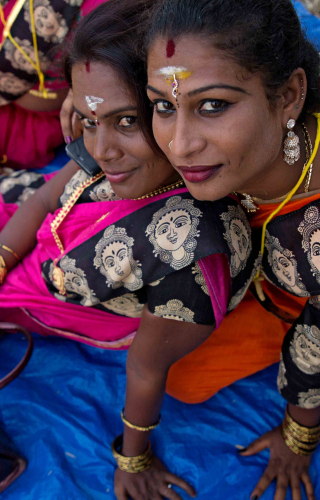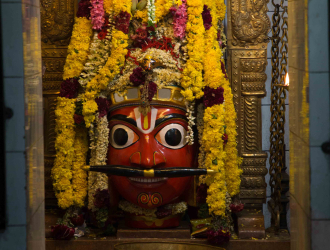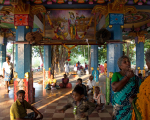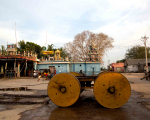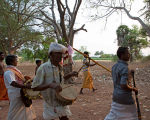Every year in the month of Chaitra (April/May), the sleepy village of Koovagam comes to life during an 18-day festival which is attended by people from the transgender community across Tamil Nadu.
I find the Koovagam festival one-of-its-kind in India, and I have been documenting it for a decade now. Although shooting in the extreme summer heat is a challenge, the vitality of the atmosphere compels me to return every year. The festival has gained much popularity, and is nowadays attended by transgender people as well as the larger LGBTQI community from across India, and even Sri Lanka and Southeast Asian countries.
The festival is held to commemorate a story from the Mahabharata, where Aravan, one of the sons of Arjuna, offers himself as sacrifice to ensure victory for the Pandava army in the battle of Kurukshetra. Aravan is the chief deity of the Kuttantavar cult and a divinity of the Draupadi cult in rural Tamil Nadu. He is also worshipped by the transgender people of the region, where they are known as aravanis or, more specifically, as thirunangai (for transgender women) and thirunambi (transgender men).
Koovagam is located around 25 km from Viluppuram, which is the nearest transport hub and district capital. When I attend the Koovagam festival, I stay at Viluppuram and commute daily to the village. The epicentre of the festival is the Kuttantavar temple in Koovagam village. The followers of Kuttantavar have 32 temples spread across the districts of Coimbatore, Erode, Vellore, Salem, Cuddalore, Tiruvannamalai and Villupuram in Tamil Nadu and the union territory of Pondicherry. The image of Aravan kept in the temple sanctum is only his severed head. His face is painted bright red, and he has a Vaishnava tika on the forehead, symbolic of his devotion to Lord Krishna. During the festival, the head and pupils are given a fresh coat of paint and brought out of the temple to be paraded through the village.
The three major rituals enacted during the Koovagam festival are the marriage between transgender women and Aravan, his sacrifice the next day, and his widowed partners mourning his death. The rituals are based on events from the Tamil renditions of the Mahabharata, where Aravan appears as the son of Arjuna and the Naga princess Ulupi.
According to these versions of the epic, Arjuna was married to the princess during his one-year exile in India’s Northeast. Aravan grew up as a splendid Naga warrior and participated in the battle of Kurukshetra on behalf of the Pandavas. On Krishna’s request, he offered himself as sacrifice to appease Goddess Kali, which was necessary to ensure victory for the Pandavas. Krishna, who was the main strategist for the Pandavas, offered Aravan three boons for his selfless act. His first boon was that his death in the battlefield would be heroic; the second boon was that he would be able to see the entire battle of Kurukshetra even after death. The third and final boon was that he would be married before he dies. Since no woman was willing to suffer imminent widowhood, no one volunteered. To fulfil Aravan’s third wish, Krishna transformed himself into the enchantress Mohini and married him. The marriage was consummated, and the next day Aravan offered himself in sacrifice to Kali. Mohini was heartbroken and mourned her widowhood, before she transformed back to Krishna. Of the three boons granted by Krishna, the first and third boons are ritualised by the Kuttantavar cult at the Koovagam festival, while the Draupadi cult includes only the second boon in their rituals.
The festival consists of various cultural events leading up to its climax on a full moon day. On the 14th day of the Koovagam festival, transgender women dressed as Mohini gather from daybreak at the Kuttantavar temple. For their marriage to Aravan, they wear their finest sarees, new bangles, gajras (floral garlands), gold jewellery and bridal makeup. They carry with them various puja items, kalasha (pot) and thali (mangala sutra or sacred thread) made of turmeric. In the sanctum sanctorum, a group of priests officiate the marriage ceremony and each transgender woman gets married to Aravan individually. The priests act as representatives of Aravan and tie the thali around their neck and apply sindoor (vermillion) in the partition of their hair, both symbols of marriage for Hindu women.
On that night and the next day, the transgender women may engage in sexual activities to mark the completion of marriage. On the 16th day, the image of Aravan is taken out in a procession. During this procession, followers of the Aravan and Draupadi cults along with onlookers gather for their deity’s darshan, and participate in pulling his chariot. The newly married transgender women gather at a designated ‘mourning ground’ called azhukalam. When the procession reaches there, the thick floral garlands and accoutrements are removed from Aravan’s effigy. This symbolises the removal of Aravan’s flesh during his sacrifice on the battlefield. After his death, his widowed partners collectively mourn by removing their thalis (mangala sutra) and smashing their bangles. They cry aloud, beat their chests and lament their widowhood, before bathing and changing into fresh white sarees as Hindu widows commonly wear. It should be noted that this widowhood is only symbolic and temporary, and the transgender women return to their usual colourful garments after a short period of time. They can return next year to repeat the marriage ritual.
One of the challenges of shooting the Koovagam festival is to avoid stereotyping and objectifying the transgender community. The festival is not just a cultural event but an occasion for the collective expression of transgender identity. Beyond the beautiful faces are hidden many struggles for social recognition, respect and equal opportunities which are lost when we eroticise them as a group. Gender is a powerful collective identity for the transgender community; it binds them. For cisgender people, it can be difficult to understand the gender dynamics. A festival like Koovagam is a rare occasion when the transgender community can openly flaunt their sexuality and gender identity in public without facing censorship or mockery. This is as much a political statement as a cultural one. The collective lamentation of Aravan’s death can also be seen as the community’s catharsis and their collective protest against the discrimination they face in society.
